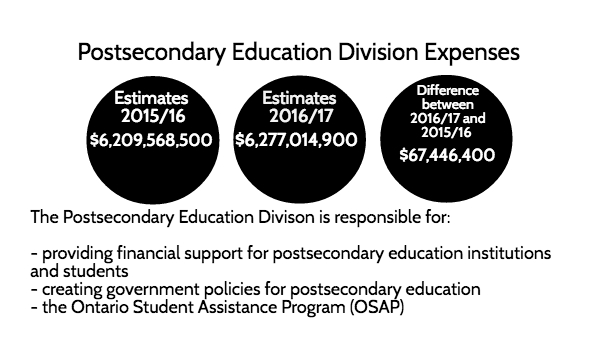Changes are coming to the Ontario Student Assistance Program (OSAP) next year: good news for some students, but not for those critical of the Ontario Liberals’ spending.
The provincial government introduced the Ontario Student Grant (OSG) this spring. The grant, which comes into effect in Sept. 2017, will cover tuition for students whose families earn less than $50,000 a year.
But the grant may increase the amount that Ontario taxpayers pay towards education—contrary to initial claims made by provincial finance minister Charles Sousa—according to a Globe and Mail article published on Nov. 28.
In the article, Deb Matthews, the deputy premier and minister of advanced education and skills development, said it was “quite possible,” that provincial post-secondary spending could rise next year.
Jamie Cleary, president of the Ontario Undergraduate Student Alliance (OUSA), said the grant will help break financial barriers for students.
“We know that debt is a deterrent to some students. So the sticker price is something that hinders students from accessing post-secondary education, and that’s what this grant is trying to combat,” he said.
Cleary said streamlining OSAP and eliminating underused assistance programs will free up money to give to Ontario students.
But critics say if the money the government comes up with doesn’t match the demand for the grant, taxpayers may pay the difference.
“There’s nothing wrong with adding new projects, but this one wasn’t supposed to add to costs, and my concern is whether or not [the government] can afford it,” said Christine Van Geyn, Ontario director of the Canadian Taxpayers Federation.
Van Geyn said she is also concerned about how the updated OSG will distribute money to students.
The new OSAP system will reimburse the cost of average tuition in Ontario to students, but won’t reimburse them for their actual tuition costs. This means students working towards liberal arts degrees may receive more money than they pay in tuition, while those in engineering or medicine might receive less, since those programs often cost more.
Gayle McFadden, a spokesperson for the Canadian Federation of Students (CFS)-Ontario, said the grant is a good first step, but that the real issue is high tuition.
“There’s a lot of students and programs that won’t be covered by the grant, so I think that it’s a start, but it’s not necessarily the solution to our education that the government is selling it as,” McFadden said. “It’s just the status quo. Tuition fees are high, you go into debt, you starve for a while, that’s what students are told is the norm, and that’s a big problem.”
McFadden said she is also worried about provincial funding for the grant.
She said government spending for the OSG is tied to tuition rate increases, so if tuition goes up, so does the cost of the grant.
Currently, the framework that regulates how much Ontario tuition rates increase each year is being reworked by the government. The provincial government has been in consultation with CFS-Ontario about this framework, which should be released by the end of this month, according to McFadden.
Lower tuition would be a bigger help for students than grants, she added.
“Why don’t you just reduce tuition fees and tackle the whole issue at once?” she said. “[The government] will be spending more on this grant the more they increase tuition fees.”
– Infographic by Shanice Pereira






